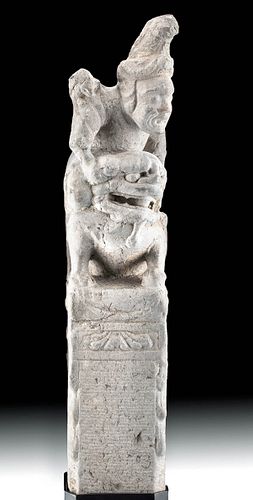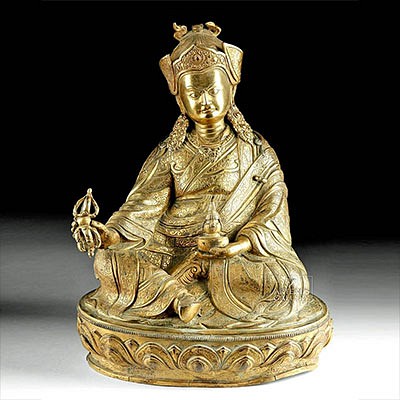Tall Chinese Ming Dynasty Stone Baluster - Man & Lion
Lot 37
About Seller
Artemis Gallery
686 S Taylor Ave, Ste 106
Louisville, CO 80027
United States
Selling antiquities, ancient and ethnographic art online since 1993, Artemis Gallery specializes in Classical Antiquities (Egyptian, Greek, Roman, Near Eastern), Asian, Pre-Columbian, African / Tribal / Oceanographic art. Our extensive inventory includes pottery, stone, metal, wood, glass and textil...Read more
Categories
Estimate:
$14,000 - $21,000
Absentee vs Live bid
Two ways to bid:
- Leave a max absentee bid and the platform will bid on your behalf up to your maximum bid during the live auction.
- Bid live during the auction and your bids will be submitted real-time to the auctioneer.
Bid Increments
| Price | Bid Increment |
|---|---|
| $0 | $25 |
| $300 | $50 |
| $1,000 | $100 |
| $2,000 | $250 |
| $5,000 | $500 |
| $10,000 | $1,000 |
| $20,000 | $2,500 |
| $50,000 | $5,000 |
| $100,000 | $10,000 |
| $200,000 | $20,000 |
About Auction
By Artemis Gallery
Mar 11, 2021
Set Reminder
2021-03-11 12:00:00
2021-03-11 12:00:00
America/New_York
Bidsquare
Bidsquare : Art of Asia | Antiquity to Present
https://www.bidsquare.com/auctions/artemis-gallery/art-of-asia-antiquity-to-present-6497
Featuring antiquities, ancient and works of art ranging from the third millennium BCE to the present from China, Japan, South and Southeast Asia, and Korea. Including jades, bronzes, lacquer, textiles, paintings, prints, sculpture, ceramics, metalwork, and other art forms in other media. Artemis Gallery info@artemisgallery.com
Featuring antiquities, ancient and works of art ranging from the third millennium BCE to the present from China, Japan, South and Southeast Asia, and Korea. Including jades, bronzes, lacquer, textiles, paintings, prints, sculpture, ceramics, metalwork, and other art forms in other media. Artemis Gallery info@artemisgallery.com
- Lot Description
East Asia, China, Ming Dynasty, ca. 1368 to 1644 CE. An incredible limestone baluser, an important part of Ming architectural style, known in Chinese as "wangzhu". It features man seated atop a crouched lion as its upper part; below this is an ornately carved post. Perched on the man's shoulder is a bird, most likely a quail as these birds were associated with the diligent study of scholars. The man is carved to have a tall coiffure with decorative elements. His face is in a grimace, with deep lines at his cheeks, his eyebrows sloping sharply down as if worried, and slightly bulging eyes. The lion has a solid body with a charming face, including a snub nose, smiling mouth full of teeth, and floppy mane that hangs over its brow. Size: 8.3" L x 8.3" W x 42" H (21.1 cm x 21.1 cm x 106.7 cm); 46" H (116.8 cm) on included custom stand.
Ming Dynasty architects continued the Chinese tradition of having important buildings - towers, pavilions, palaces, meeting halls, etc. - built atop terraces, requiring a walk up a grand stone staircase to reach them. These are bordered by balustrades punctuated by balusters. Most famously, the group of buildings known as San Da Dian (The Three Great Halls) at the Forbidden City in Beijing, feature 1460 balusters. Viewed from a distance, these resemble a stone forest. The lion on a baluster, as here, is associated particularly with bridges, such as the Lugouqiao or Marco Polo Bridge near Beijing which features 501 lions in various poses on its balusters.
Provenance: private Hawaii, USA collection; ex-private Micklautz collection, Hawaii, USA, collected from 1940-1998
All items legal to buy/sell under U.S. Statute covering cultural patrimony Code 2600, CHAPTER 14, and are guaranteed to be as described or your money back.
A Certificate of Authenticity will accompany all winning bids.
We ship worldwide and handle all shipping in-house for your convenience.
#150828A small portion of the base is lost, so the item has a custom stand to allow it to stand upright on its own. The surface is weathered as this item would have been outside for many years, but the form is generally still clear, with some areas of detail remaining. Nice deposits on the surface. There is a small area on the man's elbow that has modern paint on it, probably from rubbing up against something.Condition
- Shipping Info
-
All shipping is handled in-house for your convenience. Your invoice from Artemis Gallery will include shipping calculation instructions. If in doubt, please inquire BEFORE bidding for estimated shipping costs for individual items.
-
- Buyer's Premium



 EUR
EUR CAD
CAD AUD
AUD GBP
GBP MXN
MXN HKD
HKD CNY
CNY MYR
MYR SEK
SEK SGD
SGD CHF
CHF THB
THB
















